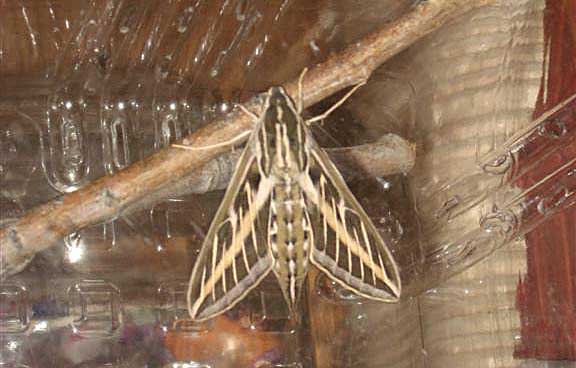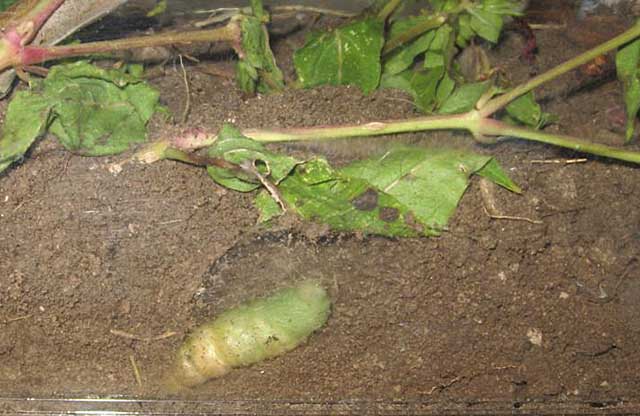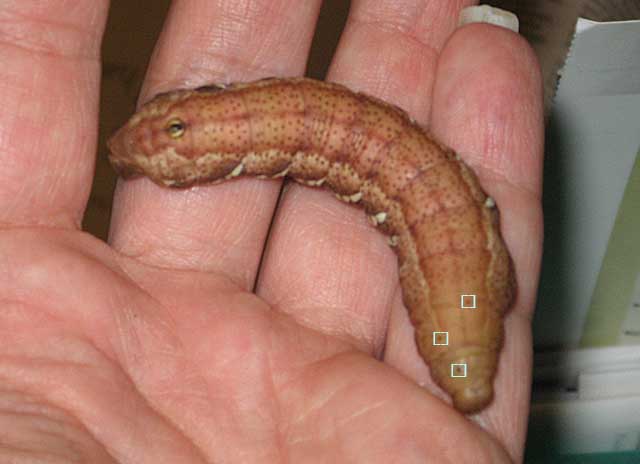Hyles lineata lineata
Hyles lineata lineata
HYE-leezmmlih-nee-AGH-tuh
(Fabricius, 1775) Sphinx
White-lined Sphinx

Hyles lineata, Cheyenne, Laramie County, Wyoming,
October 24, 2008, courtesy of Cristina J. Sheats.
This site has been created by
Bill Oehlke at oehlkew@islandtelecom.com
Comments, suggestions and/or additional information are welcomed by Bill.
TAXONOMY:
Family: Sphingidae, Latreille, 1802
Subfamily: Macroglossinae, Harris, 1839
Tribe: Macroglossini, Harris, 1839
Genus: Hyles Hubner, [1819] ...........
Species: lineata lineata (Fabricius, 1775)
|
MIDI MUSIC
.....It's a Wonderful World.....
copyright C. Odenkirk
ON.OFF
<bgsound src="world.mid" LOOP=FOREVER>
|

Hyles lineata pupation chamber, Cheyenne, Laramie County, Wyoming,
September 21, 2008, courtesy of Cristina J. Sheats.
Some sphingidae species pupate deep (up to six inches) underground. This one, Hyles lineata, appears to have chosen a site between
one and two inches beneath the soil surface in the clear enclosure.
The chamber is formed as the larvae thrashes around a bit and sweats off excess moisture. The moisture from the sweating and the compaction from the thrashing
serve to cement the chamber walls. Larvae which are not going to diapause (hibernate) for the winter, sometimes spend less than two weeks in the chamber;
larvae of other species may spend several fall and winter months in diapause before emerging the following spring or summer.
The pupa in Cristina's picture has just shed its caterpillar skin and is quite soft and a greenish yellow colour. The pupal shell usually hardens and turns
brownish within a few hours.
Most people who have turned soil in a garden have encountered moth pupae at one time or another. There are other moth families and subfamilies whose
larvae pupate underground.
Cristina writes, "This is the set up we created for our last sphinx moth guest in 2008 ... as you can see, that one was a success.
We actually fed it for about a week before it pupated. That was good, because it gave me time to research it, and it was during that time I learned some
caterpillars pupate underground - WOW! Did we learn something new! As you can see, we were absolutely blessed that after completely rearranging every
speck of dirt in his habitat, that he (or was it a she - the moth that emerged had club-shaped antennae) decided to pupate right up front where we could
watch the whole thing.
"The dates for that "sighting" are on the pictures if you want to update the White Lined Sphinx moth report on your web page, and, yes, you are more than
welcome to use my pictures.
"Well, we've completely lost sight of our current guest (Eumorpha achemon larva, August 2010), so we'll just have to wait and see where he/she
settles. Can we expect a similar length pupation? The last one was almost exactly a month."
I replied, "Recently I have received reports of Eumorpha pandorus moths (close relatives) emerging from pupae within two weeks of
pupation, but they were from the southeastern US where it is considerably warmer with a longer "growing season". I do not know if the moth will emerge in
just a couple of weeks or if it will be in a diapausing (hibernating) state, and not emerge until next spring. Much depends upon temperature and length
of daylight photoperiod that the larvae experience as they near maturity.
"I also notice what might be some parasitoid wasp/fly entry wounds (little black dots) on some of the thoracic segments of your
Eumorpha achemon larva. The spots may be flecks of dirt, but if a parasitic wasp or fly deposited eggs on the surface of the caterpillar, and the
parasitic larvae burrowed in, then no moth will emerge from this caterpillar, even if it does pupate successfully. Some parasitoids have a long ovipositor
that they insert into the larvae, enabling them to deposit eggs internally. This process also leaves a surface scar on the caterpillar larva. Hope
your larva does not have parasites, which are specific to larvae and not to humans."

Eumorpha achemon fifth instar, Cheyenne, Laramie County, Wyoming,
August 27, 2010, courtesy of Cristina J. Sheats.
I have put some little, light blue boxes around what I think might be entry wounds. Hope that is not what the spots are.
It is a bug eat bug world out there, and many found larvae have parasitoids which eventually kill the host as they mature.
Goto Main Sphingidae Index
Goto Macroglossini Tribe
Goto Central American Indices
Goto Carribean Islands
Goto South American Indices
Goto U.S.A. tables
Use your browser "Back" button to return to the previous page.
This page is brought to you by
Bill Oehlke and the
WLSS. Pages are on space rented from Bizland. If you would like
to become a "Patron of the Sphingidae Site", contact Bill.
Please send sightings/images to Bill. I will do my best to respond to
requests for identification help.
Enjoy one of nature's wonderments: Live
Saturniidae (Giant Silkmoth) cocoons.
 | 
Show appreciation for this site by clicking on flashing butterfly to the left.
The link will take you to a page with links to many insect sites. |




